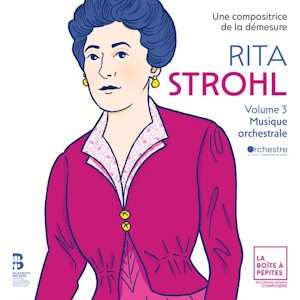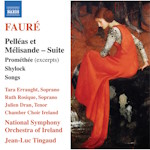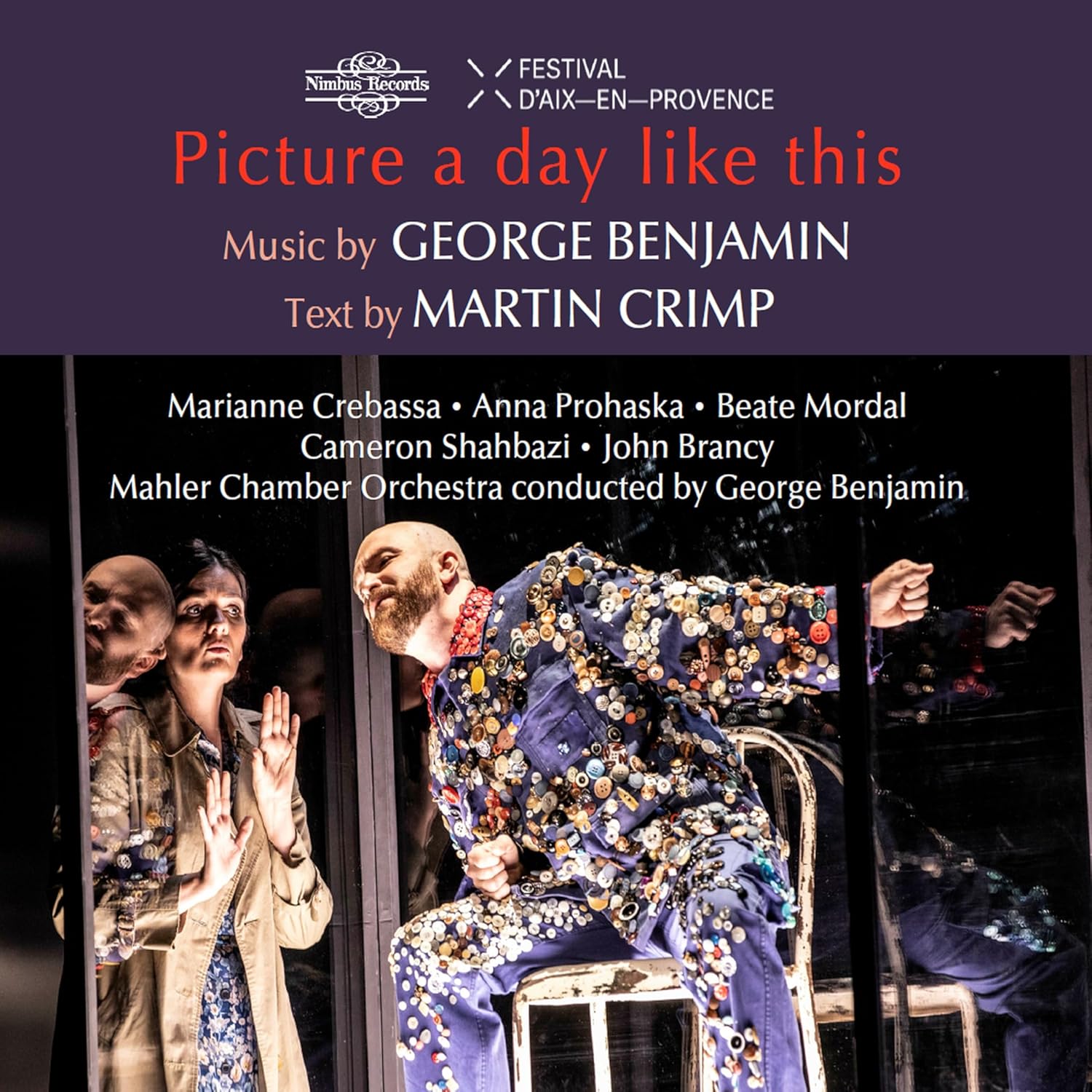
Rita Strohl (1865-1941)
Volume 3: Orchestral Music
Symphonie de la Forêt (1901 or 1903)
Les Cygnes blancs (1899)
La Flûte de Pan (1900)
La Momie (1905)
La Cloche fêlée (1905)
Yajnavalkya: Prelude to Act II (1907)
Marie Perbost (soprano), Lucile Richardot (mezzo)
Orchestre de l’Île-de-France / Case Scaglione
rec. 2023, Maison de l’Orchestre national de l’Île-de-France, Paris, France
French texts & English translations included
La Boîte à Pépites BAP10 [74]
I’ve already greatly enjoyed discovering the music of Rita Strohl through the two previous volumes in this series: a generous selection of her songs in Volume 1 (review) and a survey of almost all her chamber music in Volume 2 (review). Based on those experiences, I was eager to experience Strohl’s work as an orchestral composer.
I learned from the comprehensive documentation that Strohl’s first steps in the orchestral genre came through her orchestration of her own songs and thus we have some overlap with Vol 1 of this series: on those discs we can hear La Flûte de Pan, La Cloche fêlée and La Momie in their original versions for voice with piano and it’s been most interesting to compare and contrast the two versions of each song. La Flûte de Pan is the fourth song of the twelve that constitute the cycle Bilitis (1900). The cycle is for soprano and piano. The original version is most attractive but the orchestral version adds an extra dimension; you won’t be surprised to learn that prominent use is made of the flute. The orchestration is beautifully and imaginatively done. Marie Perbost is first class and communicates the song excellently – as does Elsa Dreisig in the piano version. La Momie and La Cloche fêlée both appear in the collection Dix Poésies mises en musique (1901). In their 1905 orchestral versions we hear them sung by Lucile Richardot. In La Momie (The Mummy) the piano accompaniment features a sinuous, lament-like melody in the right hand. In the orchestral version this allotted first to the cor anglais and then the clarinet, both to excellent effect. Whilst the piano version is by no means superseded the extra palette of colours in the orchestral scoring is most evocative. Richardot sings the song very well, though I have a slight preference for the richer tones of Adèle Charvet who sang the piano version. The piano accompaniment to La Cloche fêlée (The Broken Bell) is quite plain in nature. The orchestration opens up new possibilities; for one thing, we hear the chimes of the bell played by the horns. In the orchestral version the song becomes bigger, more public; in recognition of this Lucile Richardot offers some impassioned singing.
There’s one other song on this disc, Les Cygnes blancs (1899). This comes from La Règne du silence (1891), a work about which I could find no discussion in the booklet. The song is a setting of a poem by the Belgian, Georges Rodenbach (1855-1898), whose novel Bruges-la-Morte (1892) became the basis for Korngold’s opera Die tote Stadt. Strohl’s piece was completely new to me. This seems to be the earliest example, at least on this album, of Strohl as an orchestrator. The scoring strikes me as confident and imaginative. This extended song, which is sung very well by Marie Perbost, is impassioned and most interesting.
Also new to me is the orchestral Prelude to Act II of Yajnavalkya. As with La Règne du silence, the notes don’t really say very much about Yajnavalkya, other than that it’s “a large-scale dramatic work”. It appears that this particular music illustrates a king alone in his palace, thinking “with terror of the visit he is about to receive” but I’m afraid no real context is supplied. The music that we hear is restless in nature, so I can appreciate that it depicts a troubled soul. The orchestration is resourceful and I like the way that the harp is used at the end as the piece comes to a tranquil conclusion. However, I wished I’d been told more about the piece.
The main event on this programme is the Symphonie de la Forêt. This is a work on an ambitious scale and it’s the most substantial composition by Rita Strohl that I’ve encountered to date; this performance plays for 44:54. It’s cast in four movements; the outer movements, which are substantial, encase two much shorter ones; these inner movements follow each other attacca. Each movement bears a title. The first, which plays for 15:30, is entitled ‘L’Étang’ (The pond). After a hushed, atmospheric opening, the music becomes very richly scored; the textures are often opulent, though not excessively so. The orchestra is handled with great assurance and apart from the richness of the textures one feature of Strohl’s style which I noticed very strongly is that she seems to have the knack of selecting just the right instrument on which a particular melodic line or piece of detail should be voiced.
The second movement is much shorter (6:49); it bears the title ‘L’Âme en peine’ (The sorrowful [or grieving] soul). Unsurprisingly, with a title such as this, the music is troubled and restless in nature. Once again, the scoring is very full, with the instruments used imaginatively. This movement gives way without a break to another short movement (3:40) which bears the title ‘Marche funèbre d’un scarabée’ (Funeral march of a beetle). In the booklet this is referred to as a scherzo in 4/4 time. The scoring is light and deft, suggestive of beetles and other insects but if I hadn’t known the title, I don’t think I’d have guessed that the music is a funeral march, despite the fact that at one point (just after 2:00) there’s a brief reference to the ‘Dies irae’ melody.
The last movement is the longest (18:54). It carries the title ‘Chasse à l’aurore – Aurore et lever de soleil’ (Hunt for daybreak – Daybreak and sunrise). After a slow, tense introduction, Strohl introduces quicker hunting-style music in compound time; this is vigorous and exciting. There’s a rather lovely slower episode (from around 6:00 until 10:30) in which a solo viola is prominent, after which the hunting-style music resumes. The final pages present a ‘big finish’ with Strohl’s depiction of the grandeur of a sunrise.
I’ll be honest; I don’t yet know quite what I make of Symphonie de la Forêt. In many ways it’s impressive – the music is never less than attractive and the way Strohl handles a large orchestra is imaginative. Quite whether it hangs together as a symphony I’m less sure. Indeed, there is a suggestion in the notes that each movement might be more of a symphonic poem and I think there’s a lot in that. I’ve enjoyed making the work’s acquaintance and I intend exploring it further. On this evidence I’d also like to hear Strohl’s Symphonie de la mer (1902). Based on my listening to date I’m not sure that this recording has unearthed a lost major French symphony. I am sure of two things, though. One is that Symphonie de la Forêt was well worth recording in order to let people hear it for themselves. The other is that this work, and the other pieces on the disc, show how ridiculously patronising and misogynistic were some of the contemporary press reviews of Rita Strohl’s orchestral music. On this evidence, she was a confident orchestral composer whose music is well worth hearing.
All the performances on this disc are first rate. I’ve already commented on the fine singing of both of the vocal soloists. The Orchestre de l’Île-de-France is clearly a most accomplished ensemble. They give assured, skilful and committed performances of music that can only have been unfamiliar to them. The American conductor, Case Scaglione is their Music Director (since the 2019/20 season). He demonstrates a fine feeling for this music. He and his players benefit from excellent recorded sound.
In my reviews of the preceding two volumes, I’ve been warm in my praise of the stylish way in which La Boîte à Pépites present these recordings. In most respects, that’s true once again. Everything is housed in a hardback book-style cover. The documentation is in French and English and the booklet – though in truth such a description is a bit unfair (it runs to 64 pages) – contains attractive illustrations, the texts and translations and an extended essay by Héloïse Luzzati on the composer’s life and musical development, which is printed in all three volumes. There’s also a substantial discussion of the music by Constance Luzzati and here, I’m afraid, some doubts which arose with Vol 2 now become stronger. Constance Luzzati discusses the pieces along what I might term thematic lines and in so doing she as a tendency to dart from one piece to another. I found myself frustrated in particular that there wasn’t a conventional programme note about Symphonie de la Forêt; had there been, I’m sure my appreciation of the music would have been enhanced. And I’ve already mentioned that the discussion of the Prelude to Act II of Yajnavalkya is insufficient.
Still, that’s a relatively minor disappointment. The key thing about this release is that it introduces us to some very interesting and worthwhile music in excellent performances. I’ve thoroughly enjoyed my exploration of the music of Rita Strohl across these three volumes. She was clearly a composer of substance and La Boîte à Pépites have put us in their debt by making so much of her output available for us to get to know and appreciate. I hope there may be more recordings of Strohl’s music in the future.
Previous review: David McDade (September 2024)
Buying this recording via a link below generates revenue for MWI, which helps the site remain free.



















